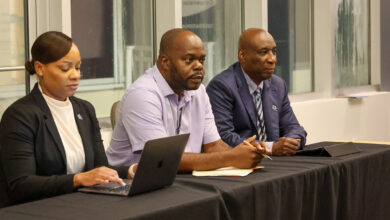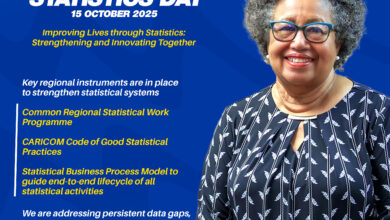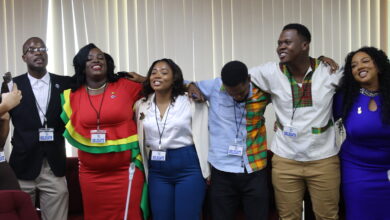(CARICOM Secretariat, Turkeyen, Greater Georgetown, Guyana) The East African Community delegation which was on a study tour at the Caribbean Community (CARICOM) Secretariat left for Bridgetown, Barbados where they will hold discussions with the CARICOM Single Market and Economy (CSME) Unit.
The 11-member EAC Secretariat team representing the five partner states – Tanzania, Burundi, Rwanda, Uganda and Kenya – wrapped up their Georgetown sessions on Thursday evening after what delegation head Dr. Nyamajeje Weggoro, EACS Director, Productive and Social Sectors, described as a very fruitful exercise.
The tour, which began on Wednesday 1 October 2008, was requested by the EACS and was aimed at studying and analysing the progressive movement of the integration processes from the free trade area to common market and subsequently to CSME.
The EACS had expressed an interest in understanding the role played by the CARICOM Secretariat in the integration process; examining the regulatory framework governing the CSME and ascertaining the key processes that governed the negotiations for the CSME.
Following general presentations on the Offices of the Secretary-General, the Deputy Secretary-General and the General Counsel, as well as the Directorates of Human and Social Development (HSD), Trade and Economic Integration (TEI) and Foreign and Community Relations (FCR), the delegation held discussions with the TEI. Team members were particularly interested in Tax Policy Administration, the CSME and Sectoral Programmes, the implementation status of the CSME with specific emphasis on the sequential implementation processes and key challenges that have been faced in the various processes and how they have been overcome.
The team also had talks with the HSD Directorate focused on Human Resource Development.
“We have learned a lot from you,” said Ms. Polly Gitimu, Senior Assistant Director, Ministry of Lands, Kenya at the conclusion of the Georgetown leg of the tour.
CARICOM Deputy Secretary-General, Her Excellency Lolita Applewhaite, said she was happy that the experience was useful and pointed out that the CARICOM Secretariat also benefitted from the exchange. She said the Secretariat was willing to provide the EAC with additional assistance and expected the visit to be the beginning of ongoing dialogue between the two Secretariats.
In an interview following the sessions, Dr. Weggoro pointed to the similarities in vision, goals and objectives of both the Caribbean Community and the East African Community, and noted that at the heart of both integration movements are poverty alleviation, wealth creation and empowerment of the people. The EAC is a regional intergovernmental organisation with headquarters in Arusha, Tanzania. It was originally founded in 1967, but collapsed in 1977.
The Treaty for Establishment of the East African Community was signed on 30 November 1999 and entered into force on 7 July 2000 following its ratification by the Original Partner States – Kenya, Uganda and Tanzania. The Republics of Rwanda and Burundi acceded to the EAC Treaty on 18 June 2007 and became full Members of the Community with effect from 1 July 2007. The EAC aims at widening and deepening cooperation among the Partner States in the political, economic and social fields for their mutual benefit. The EAC countries established a Customs Union in 2005 and are working towards the establishment of a Common Market by 2010. A Monetary Union is envisaged by 2012. The ultimate goal is a Political Federation of the East African States.
The five-member EAC covers an area of 1.8 million kilometers, has a population of about 118 million and a combined GDP of $41B.





